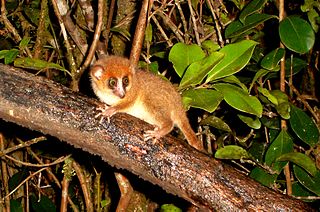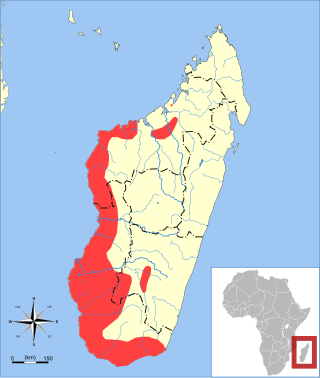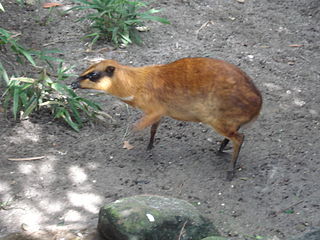
The common flat-tail gecko is a gecko endemic to Madagascar. It is found in eastern Madagascar and on the islands Nosy Bohara and Nosy Mangabe. These geckos live in tropical rain forests. They reach a total length of 330 mm.

The Nesomyidae are a family of African rodents in the large and complex superfamily Muroidea. It includes several subfamilies, all of which are native to either continental Africa or to Madagascar. Included in this family are Malagasy rodents, climbing mice, African rock mice, swamp mice, pouched rats, and the white-tailed rat.

The Malagasy rodents are the sole members of the subfamily Nesomyinae. These animals are the only native rodents of Madagascar, come in many shapes and sizes, and occupy a wide variety of ecological niches. There are nesomyines that resemble gerbils, rats, mice, voles, and even rabbits. There are arboreal, terrestrial, and semi-fossorial varieties.

The golden-brown mouse lemur, also known as the (Lac) Ravelobe mouse lemur, is part of the Cheirogaleidae family, and the smallest species of lemur. It is arboreal, nocturnal and usually social. It get its name from the color of its body. Like several other mouse lemurs, like the brown mouse lemur, it is a small primate that has a brown dorsal side and a whitish-grey for its ventral side of the body. All lemurs live in Madagascar. This species was discovered in 1994.

The brown mouse lemur is a small primate, and like the other mouse lemurs can only be found on the island of Madagascar. They are known also as the rufous mouse lemur, eastern rufous mouse lemur, red mouse lemur, or russet mouse lemur. Its dorsal side is brown or reddish-brown, while ventrally it is a whitish-grey.

The hairy-eared dwarf lemur, or hairy-eared mouse lemur, is one of the most scarcely known lemurs. A. trichotis is a nocturnal lemur that is endemic to Madagascar. It was originally named by Albert Günther in 1875 as Cheirogaleus trichotis as part of the Cheirogaleidae family, or the dwarf lemurs. In 1967 Petter-Rousseaux and Petter reassigned the lemur to its own genus and is the now only member of the genus Allocebus. The hairy-eared dwarf lemur was thought to be extinct until its rediscovery in 1989 in a northeastern primary lowland rainforest. The population of these mammals is shown to be severely decreasing and largely fragmented throughout Northern and Eastern Madagascar rainforests; most likely due to hunting, trapping, slash-and-burn agriculture as well as habitat fragmentation.

The Madagascar dry deciduous forests represent a tropical dry forest ecoregion situated in the western and northern part of Madagascar. The area has high numbers of endemic plant and animal species but has suffered large-scale clearance for agriculture. They are among the world's richest and most distinctive dry forests and included in the Global 200 ecoregions by the World Wide Fund. The area is also home to distinctive limestone karst formations known as tsingy, including the World Heritage Site of Bemaraha.

Ankarafantsika National Park is a national park near Andranofasika in the Boeny Region of Madagascar. The closest city is Majunga 115 kilometres (71 mi) north of the park. Ankarafantsika is mostly tropical in climate type. The Sakalava people are the predominant ethnic group living and farming here. The greater big-footed mouse lives in the park and is not known anywhere else.

Coquerel's sifaka is a diurnal, medium-sized lemur of the sifaka genus Propithecus. It is native to northwest Madagascar. Coquerel's sifaka was once considered to be a subspecies of Verreaux's sifaka, but was eventually granted full species level, and is listed as Critically Endangered on the IUCN Red List due to habitat loss and hunting. In popular culture, it is known for being the species of the title character in the children's TV show Zoboomafoo. The species was named after French entomologist Charles Coquerel.

The bastard big-footed mouse is a species of rodent in the family Nesomyidae. It is found only in Madagascar. Macrotarsomys bastardi is the smallest-bodied of the three species recognized within the genus Macrotarsomys. Two subspecies have been recognized however 2004 studies did not find consistent differences between the subspecies and recommended "subspecific epithets be abandoned for this species".
Big-footed mice (Macrotarsomys) are a genus of rodent in the family Nesomyidae. It contains the following species:

The greater mouse-deer, greater Malay chevrotain, or napu is a species of even-toed ungulate in the family Tragulidae found in Sumatra, Borneo, and smaller Malaysian and Indonesian islands, and in southern Myanmar, southern Thailand, and peninsular Malaysia. Its natural habitat is subtropical or tropical, moist, lowland forest.

Uroplatus sikorae, commonly referred to as the mossy leaf-tailed gecko or the southern flat-tail gecko, is a species of lizard in the family Gekkonidae. The species is endemic to Madagascar. It is a CITES II protected animal due to habitat loss.

The Malagasy mountain mouse or Koopman's montane voalavo is a rodent within the subfamily Nesomyinae of the family Nesomyidae. It is monotypic within the genus Monticolomys, and is closely related to the big-footed mouse (Macrotarsomys). It is found in the highlands of eastern Madagascar. A small mouse-like rodent, it is dark brown on the upperparts and dark gray below. It has small, rounded, densely haired ears and broad feet with well-developed pads. The long tail lacks a tuft at the tip. The skull is delicate and lacks crests and ridges on its roof.

Petter's big-footed mouse, is a Madagascan rodent in the genus Macrotarsomys. With a head and body length of 150 mm (5.9 in) and body mass of 105 g (3.7 oz), it is the largest species of its genus. Its upper body is brown, darkest in the middle of the back, and the lower body is white to yellowish. The animal has long whiskers, short forelimbs, and long hindfeet. The tail ends in a prominent tuft of long, light hairs. The skull is robust and the molars are low-crowned and cuspidate.

The Bongolava mouse lemur is a species of mouse lemur endemic to Madagascar. It lives in western deciduous forest within a limited range, including Bongolava Forest and Ambodimahabibo Forest between the Sofia River and the Mahajamba River.

The rhinoceros chameleon is a species of chameleon that gets its common name from its horn-like nose which is most prominent in males. It is endemic to dry forests in Madagascar.
The western falanouc is a rare mongoose-like mammal endemic to Madagascar. Until recently, the eastern falanouc was the only recognized species in the genus Eupleres. In 2010, Goodman and Helgen provided morphological evidence showing the two falanoucs are each a separate species and are found in separate geographical locations. E. major is larger and browner compared to E. goudotii and has a diet consisting mainly of invertebrates such as worms, snails, and slugs.

















